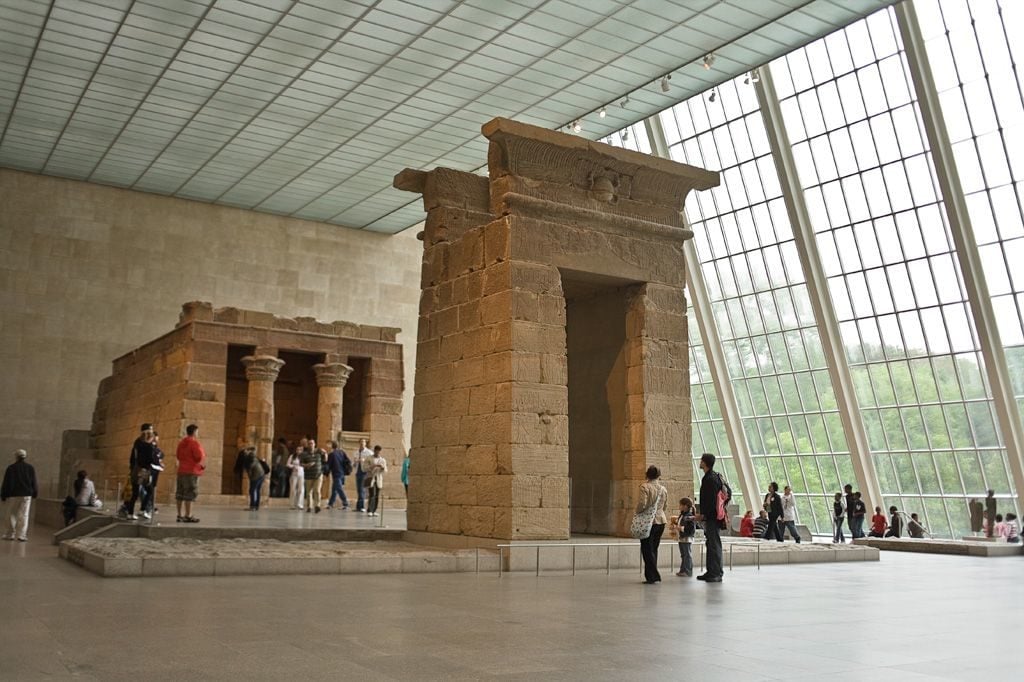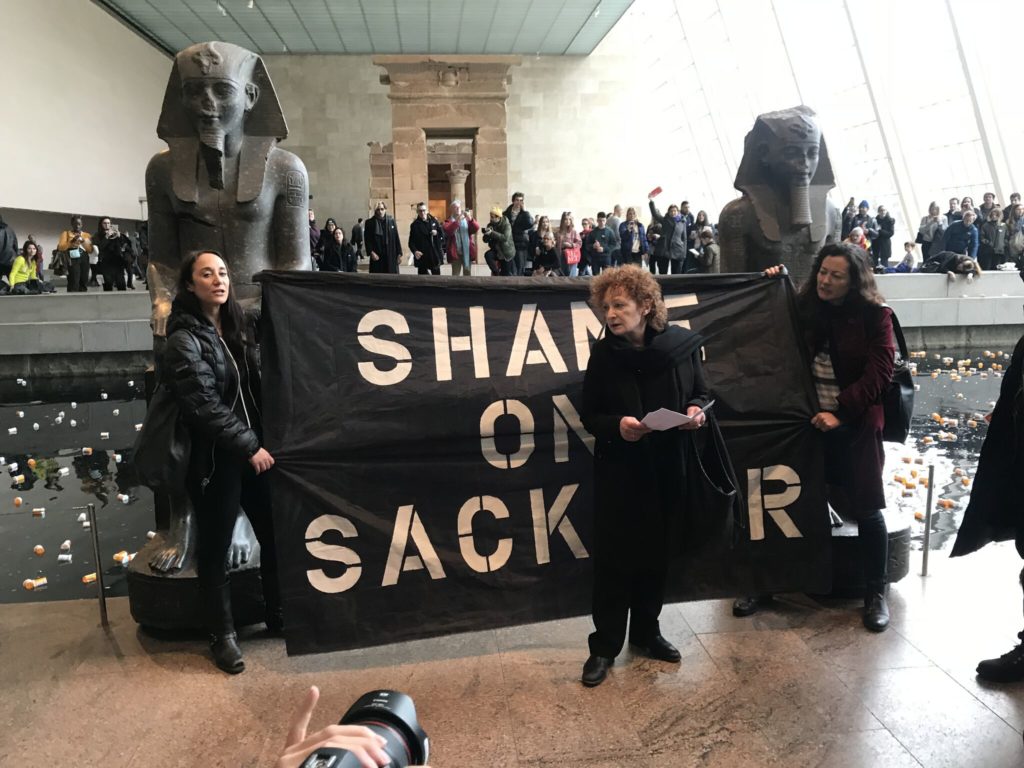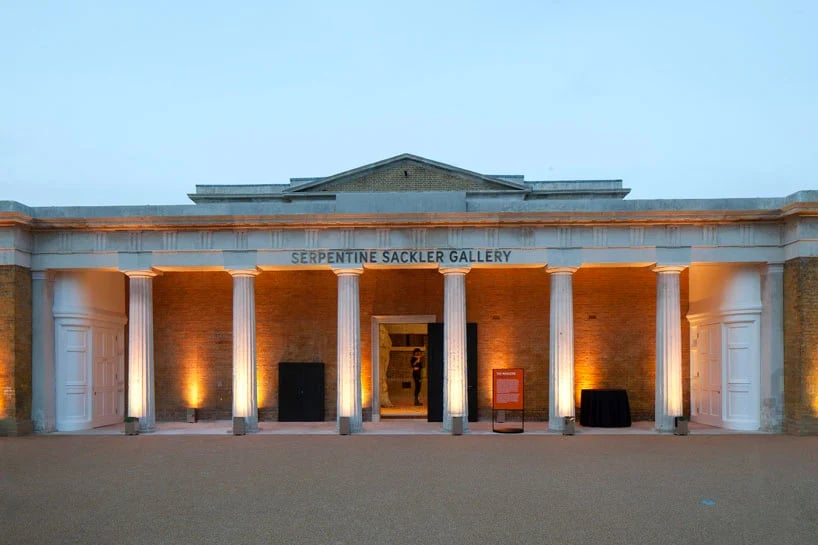Museums & Institutions
In a Landmark Move, the Metropolitan Museum of Art Has Removed the Sackler Name From Its Walls
The news was announced in a joint statement with the Sackler family.

The news was announced in a joint statement with the Sackler family.

Sarah Cascone

The Metropolitan Museum of Art in New York has dropped the Sackler name from its building. The move is perhaps the museum world’s most prominent cutting of ties with the disgraced family since their company Purdue Pharma’s guilty plea to criminal charges connected to marketing of addictive painkiller OxyContin in 2020.
The decision, which came after more than a yearlong review by the museum, was reportedly mutual and made “in order to allow the Met to further its core mission,” according to a joint statement issued by the Sackler family and the institution.
“Our families have always strongly supported the Met, and we believe this to be in the best interest of the museum and the important mission that it serves,” the descendants of Mortimer Sackler and Raymond Sackler said in a statement. “The earliest of these gifts were made almost 50 years ago, and now we are passing the torch to others who might wish to step forward to support the museum.”
Institutions have faced increasing pressure to sever relations with the Sacklers in recent years as part of a growing push to hold institutions and other cultural groups accountable over where their money is coming from. (Other donors that have come under fire include arms dealers and oil companies.)
Seven spaces at the Fifth Avenue flagship bore the Sackler name. The biggest was the Sackler Wing, which opened in 1978, and includes the Sackler Gallery for Egyptian Art, the Temple of Dendur in the Sackler Wing, and the 1987 addition of the Sackler Wing Galleries.
The day of the announcement, Patrick Radden Keefe, the author of Empire of Pain: The Secret History of the Sackler Dynasty, visited the museum to find that the family’s name had already been removed.
Thought this might be a nice afternoon for a stroll through the Met. Turns out by the time @metmuseum announced that it was purging the Sackler name earlier today, it had already happened.
Pics from Dec 2020 :: Dec 2021. pic.twitter.com/CfMyY7gagh
— Patrick Radden Keefe (@praddenkeefe) December 9, 2021
Efforts to strip the Sacklers of the soft power afforded by their philanthropic giving have been led by artist Nan Goldin’s advocacy organization Sackler P.A.I.N., which she founded after overcoming her own painkiller addiction.
The group has staged highly visible protests at institutions including the Met as well as the Louvre in Paris, which quietly removed the Sackler name from both its wing of Oriental antiquities and website in 2019, and the Solomon R. Guggenheim Museum in New York, which is still home the Sackler Center for Arts Education.
“We’re so happy that the Met has listened to P.A.I.N. and to their own moral conscious,” Goldin and P.A.I.N. told Artnet News in a statement. “We’re grateful to the Met for leading the charge and wait for all of the other museums who bear their name to follow suit.”

Nan Goldin speaking at the protest at the Met in 2018. Photo by Michael Quinn.
The survivors of OxyContin addition and their families, as well as institutions, had hoped that Purdue Pharma’s $4.5 billion bankruptcy settlement would include provisions that would allow nonprofits to terminate naming agreements with the Sacklers. That didn’t make it into the final terms of the settlement, which means the Sacklers and the Met had to reach some sort of behind-the-scenes agreement for their name to come down.
“The Met has been built by the philanthropy of generations of donors—and the Sacklers have been among our most generous supporters,” Dan Weiss, the Met’s president and chief executive officer, said in a statement. “This gracious gesture by the Sacklers aids the museum in continuing to serve this and future generations. We greatly appreciate it.”
As part of the settlement, the Sacklers have a nine-year ban on any new naming rights for their charitable donations.

The Serpentine Sackler at its opening in 2013. Photo ©Luke Hayes, courtesy of the Serpentine Galleries.
The Met was already among a number of museums that had begun to reject Sackler donations. London’s National Portrait Gallery turned down a $1.3 million gift in 2019, after Goldin threatened to cancel a planned exhibition there. The South London Gallery, the Tate Modern in London, the American Museum of Natural History in New York, and the Jewish Museum Berlin have all pledged not to take the family’s money.
There are three branches of the Sackler family, descended from brothers Mortimer, Raymond, and Arthur Sackler. When Arthur died in 1987, before the invention of OxyContin, his brother purchased his one-third share in their company Purdue Pharma. (Arthur and his immediate family didn’t directly benefit from the drug, and their namesake spaces include the Elizabeth A. Sackler Center for Feminist Art at the Brooklyn Museum and the Smithsonian’s Arthur M. Sackler Gallery in Washington, D.C., as well as two galleries at the Met that will be spared in the purge.)
The Sackler name as related to Mortimer and Raymond still retains a place of pride at numerous institutions, such as the Natural History Museum’s Sackler Institute for Comparative Genomics and Sackler Educational Laboratory.
In London, the British Museum has the Raymond and Beverly Sackler Rooms; the Victoria and Albert Museum has the Sackler Courtyard; the National Gallery has the Sackler Room; and the Tate Modern has the Sackler Escalator. And while the Serpentine Galleries has taken the Sackler name off its website, the north gallery is still identified as the Serpentine Sackler on its facade.
Artnet News reached out to all of the museums listed above in light of the Met’s decision. The only institution to respond by press time, the National Gallery, stated that the naming “was a historic donation dating back to 1993 and therefore there are no current plans to change the name of the room.”
Still, the Met stands to serve as an example for other institutions considering dropping the family name, given its prominence at the museum. In addition to the Sackler Wing, the museum’s display of ancient Near Eastern art has had the Raymond and Beverly Sackler Gallery for Assyrian Art and the Richard and Jonathan Sackler Study Center since 1981, while the European paintings section has been home to the Dr. Mortimer D. Sackler and Theresa Sackler Gallery since 1986.
UPDATE, 12/10/21: Two additional museums offered a comment about their Sackler-named spaces in emails to Artnet News.
“We are not considering the removal of signage related to past or present donors,” V&A spokesperson said.
“The British Museum received funding from the Raymond and Beverley Sackler Foundation between the 1990s and 2013,” British Museum spokesperson said. “This funding has supported galleries, education facilities, curatorial posts, and research projects.”
UPDATE, 12/13/21: The Jewish Museum Berlin, which had previously pledged to reject donations from the Sacklers in April 2019, took down the family name from its former Sackler staircase over the summer.
“The staircase is no longer called the ‘Sackler Staircase,’ instead it is referred to as the ‘Staircase adjoining the Axis of Continuity,'” a museum spokesperson told Artnet News in an email. “In the course of the redesign of the permanent exhibition including the axes in the Libeskind Building in 2020, the Jewish Museum Berlin decided not to renew the sign indicating support from the Sackler Foundation and not to honor the Sackler family as patrons at this location in the future. The donations will not be repaid as the funds have already been spent and any repayment would require taxpayers’ money.”